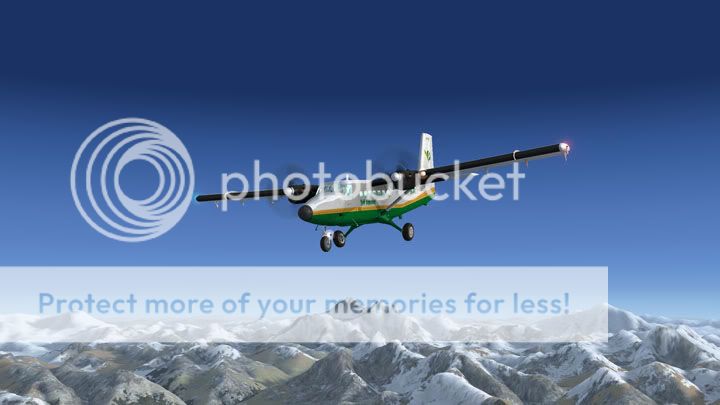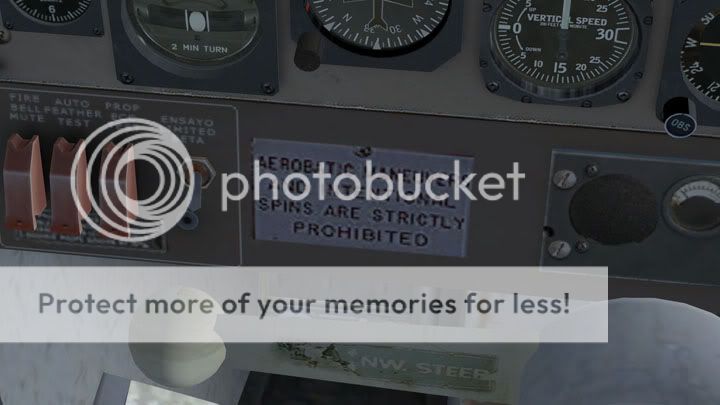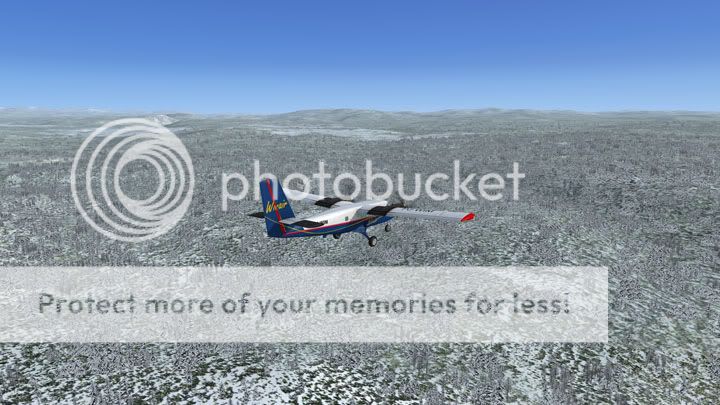Here’s another review brought to you by the VFR Reviews team with thanks to Aerosoft for providing the aircraft in which I now fly fairly often.
As with most addons the process begins with a download, and in this case the download comes in at around 125 megabytes and after installation, which is very simple as are most payware installations, the manual says that you would’ve lost a total of around 600MB of hard drive space. I’m not completely sure about this, since it’s never occurred to me to actually monitor disk space to find out, but I suppose I better start doing that in the future.
The download itself comes down relatively quickly, and I’m in Thailand, so I imagine the majority of you who live in the more internet-friendly regions of our slowly toasting planet will have no trouble in acquiring this fine addon.
Now, it’s slowly become apparent to me that in reviewing items of the payware variety, it’s imperative that you read the manual. I still, however, don’t do this much. Instead I just jump right in, fool about, and once I’ve got first impressions done and over-with, I’ll then read the manual.
The first thing I noticed in this aircraft, and indeed the first thing I notice with most aircraft is the sound, typically because Flight Simulator, after having loaded to 100%, tends to play sounds, briefly pause, and then begin rendering the simulation. So, I make this statement: This aircraft is considerably loud.
It’s one of the greater things about this aircraft though, since the sound quality is very good, the way sounds blend in with each other is pretty awesome, and the overall feeling of the environment around the aircraft becomes quite immersive. I suppose one can liken it to typical first-person shooters, in the sense that whilst the game can be very realistic, the sounds of the gunshots are actually quite quiet. If you’ve heard a real gunshot, its intensity is quite remarkable, and thus most shooters don’t really capture that, and the same can be said for most of the default aircraft in Flight Simulator.
This is why I find the sound to be one of the finer points of this aircraft. You can imagine the start up sounds of classic aircraft like spitfires or mustangs as those sounds have as much to do with what the aircraft is and what it represents as its airframe or paint scheme. A quick search on YouT[s][/s]ube for the ‘Twotter’, as it’s affectionately known, and you’ll see that the sounds are indeed quite accurate, and I don’t really find much fault in that area.
Moving on though, the things that most people want to read about are visuals. So, how does it look?
It looks spectacular, from the outside. Inside isn’t as impressive, but we’ll get to that later. Outside the aircraft is of seriously good quality, and has all of the features that Flight Simulator’s graphics engine allows for, including self-shadowing, bump-mapping, light-bloom, everything. Even the texture detail is very nice, but we do have a few issues with those, since there are a few noticeable areas where the textures don’t appear to line up correctly. They’re not blatantly obvious, and most people wouldn’t notice them, but if you do look closely they’re there. Another thing which I found quite funny is the fact that the tyres reflect the world like the rest of the aircraft. Perhaps that’s to simulate very shiny tyres which are very polished, I don’t know, but these are just silly things I’m picking on now. Finally, the textures, in certain areas can get a little blurry, but overall still good quality for payware.
Moving on, we also have five variants of the aircraft including a wheeled version, the same wheeled version only with more modern equipment like GPS, a wheeled version with retractable skids, a skidded version, and finally one with floats. Not only that, but we have a total of fifteen paint jobs, one scheme for the skid version, one scheme for the wheel and skid version, two for the floats version, seven for the regular, and a final four for the ones with more modern-day systems.
What kinds of details do we expect from this aircraft though? Most of you probably wouldn’t be into examining every single detail, but I am, and I’m quite pleased with the results. In fact, there’s something I’d like to point out.
In the manual, the front page shows the title of the aircraft obviously, and then shows a picture, a picture of the DHC-6-100 Kenn Borek Air Ltd. version. The notable thing about this is the fact that it has landing skids, not gear, nor skids with gear. And the image itself is of the leading skid. Nothing else. A rather odd choice, but it becomes apparent that they want to let people know how detailed the thing is, because looking at it we see each individual metal strip that make up the suspension’s construction.
The thought that comes to mind when seeing this (for me anyway) is ‘pre-rendered’. So, I started up FS for the twenty-eighth time for this review, loaded a flight with the subject of the screenie, and examined all three legs.
Sure enough, there they are, the metal suspension strips, each one modelled quite nicely, very visible, and of course, very impressive.
One has to ask though, if they’ve put this kind of detail into the thing, surely the frame hit must be considerable. Well nope, it isn’t. When compared to similar aircraft in size or function, such as the Grand Caravan or Maule, the Twotter gets roughly the same frame rate, so we’re getting great quality, plenty of detail, and at little cost, performance-wise.
We’ve addressed the basic things that most people look for in an addon, but now we enter the realism stage, where we forget about the actress’s looks, and start getting concerned about her abilities.
A handy thing about this day and age is that the internet provides us with many resources, and I can safely say that taking off is quite realistic, or so a video would have me believe. Can’t say much about anything else, because YouT[s][/s]ube videos and performance data will only get you so far, and I’d honestly have to track down a real Twin Otter pilot to get his certified opinion of the plane, but since I don’t really have the time, nor the resources, I will describe for you the experience instead.
Overall, flying the aircraft is a pleasant experience, with movements being nice and smooth, and that’s one of the funny things, actually. The ailerons appear to be quite large in surface area, and not subtle in range of motion, so I find it a bit strange that rolling the aircraft is as slow as it is. The same can’t be said for pitch and yaw control, since their actions appear to be quite realistic, but really, rolling seems quite sluggish.
Moving the flaps up and down doesn’t produce abnormal results. I notice with the default Beaver or Goose, the flaps tend to levitate the aircraft upwards fairly rapidly, and a bit unnaturally, yet don’t appear to slow down the aircraft as much as one might suppose considering their affect on altitude.
In regards to the engines, very good, imperative that you manage engine power properly with the manoeuvres you intend to perform since they do affect the aircraft considerably, but not in a bad way. For example, since the engine’s placement in relation to its centre of gravity on the aircraft is quite high, running the engines at 100% will tend to make the aircraft want to pitch downwards, and once you’re at a comfortable altitude and wish to start cruising, leaning off the power will make the aircraft pitch up a little.
This is one of the things I like about this plane, because whatever you do with the basic controls of elevator, ailerons, rudder, flaps and throttle, all seem to affect each other in realistic ways. If you’re a seriously serious simmer, and I know some of you could well be the over-the-top type, having trim controls as well as proper yoke will definitely make flying this aircraft a really exquisite experience.
Whilst mentioning handy-to-have controls, it would also be good to have a throttle quadrant of some sort, with two throttle levers, two mixture levers, and two prop levers. This is mainly because it makes flying great, but the great thing about having two throttle controls is for the float version of this aircraft. It has no water rudder, so steering whilst floating is done with differential engine control, and there’s no fun in doing that with the mouse.
There’s a loading tool provided in the start menu entries to automatically load each variation of the Twotter using a little top-down schematic of the Twotter’s cabin, where clicking a seat space will either empty the seat, or fill it with either a child, or an adult male or female. A very handy tool making each flight different more interesting in subtle ways.
A lot of the default light aircraft appear to react in ways which seem to separate controls enough to make flying with the keyboard possible. This is another interesting point, because due to my laziness, I occasionally neglect to plug in my X52 Pro when the flight I intend to enter doesn’t involve actual flying, just clever aircraft slewing along with a photo-shoot, but occasionally I do start flying by keyboard.
What’s it like? It’s quite nice actually. Flying by keyboard isn’t as hard as people have come to believe, but to be quite fair I think it would even be preferable to fly using a driving wheel rather than the keyboard.
Anyway, I suppose I should move indoors, into the virtual cockpit to see just how much of this aeroplane’s systems are actually replicated. First of all though, perhaps we should care to take a look at how pretty it is. Or not, as the case may be.
The virtual cockpit is satisfactory, but I can’t help but think that some of FS’s default cockpits are nicer. This was quite surprising to me, since the overall quality so far was quite pleasing, yet the interior appears to be a bit muddy in the textures. There’s nothing really wrong, but what I saw reminded me a little bit of the Baron 58’s VC from A Century of Flight.
Most of the virtual cockpits in the default aircraft are quite sharp and pretty, but the Twotter’s wasn’t. How odd. I compared the default Beaver’s cockpit to this one’s, and it’s fairly apparent that the Beaver’s looks better. The quality is good, but personally I’d want a little more than the tacky textures and blurry text that I actually got. Text is still readable though. God knows what could’ve happened a week ago if the textures were really bad and I couldn’t read the engine fire instructions (random failures are fun).
However, it’s not all about textures. The virtual cockpit is more or less about the representation of instruments in their natural habitat. One thing about the instruments in this case are the fact that since they’re not ‘gauge-based’, as in the default format for most virtual cockpit instruments, they use another format which allows them to be smooth, and operate at the same frame rate as the simulation. This is good news for people who can’t stand the older type which seemed to tick-like-a-clock into position.
So, now we move on to operation of the aircraft. Just using the checklists that come with the aircraft, I can safely say that the aircraft was poorly designed...
Poorly designed by de Havilland, that is. Nope, Aerosoft have done a fine job replicating the cockpit, but seriously, it’s easier to find the necessary switches and levers to start up a Baron 58 or Cessna 172, but this thing’s a nightmare. The number of things that you are required to do is quite small, but the major task is finding the switches.
What made it easier for me, though, are the multiple views, accessible by pressing the ‘A’ key. We have the pilot and co-pilot’s view, the view of the main engine-monitoring instruments, then the overhead prop, mixture, and throttle controls along with various other switches (like the windscreen wiper, which actually works), and finally another view for the other further-back overhead switches.
It doesn’t stop there though, since we get two more views, one viewing the cabin from the cockpit, and one viewing the entire cabin with the cockpit in front. And get this, there’s one final view which is a showcase image, like an ad for the views that are available.
While we’re on the topic of views though, we also have the exterior aircraft views, and they’re not really special, but rather average considering what you get with default aircraft, but they’re still nice to be able to switch to.
So, what’s the overall experience really like? All I can say is that it feels brilliant, looks brilliant, it’s interesting to fly, it’s a pleasure to fly, and it’s fun.
As a verdict, I’d say if you like prop aircraft, you can’t really go wrong with Aerosoft’s DHC-6 Twin Otter. The number of variations you get, the quality of each one, the flight dynamics, the beautiful (but loud) sounds, and of course the lovely exterior model make this twin-engine prop aircraft, a must-fly.

 FSX
FSX















Bookmarks